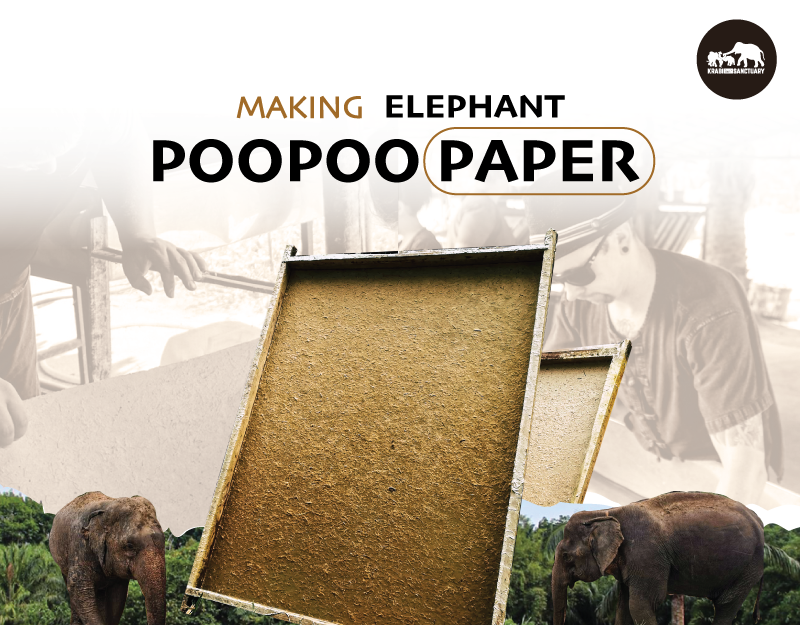News
ECO-FRIENDLY ELEPHANT DUNG PAPER
ECO-FRIENDLY ELEPHANT DUNG PAPER
Elephants are known to be amongst the most intelligent animals on earth and have complex emotions as well. Elephants help the ecosystem to expand and survive by their routine food consumption and activities. They are the largest land mammal and consume a heavy quantity of vegetation daily. This results in the production of huge amounts of elephant dung. All herbivores consume a huge quantity of fibrous diet daily that includes bamboos, grass, banana leaves, sugarcane, and a variety of wild leaves and fruits. Most of these animals have a simple digestive system which mostly helps in excreting the dung in almost raw fiber form. Other than normal dung utilities, it is also used to produce paper. An estimated daily poop of one elephant can produce up to 115 sheets of paper. A concept of NO TREE PAPER has evolved in the last couple of decades where fiber from animal poop is utilized to make paper sheets. Elephant poop is also being used in many countries to make POOPOOPAPERS. The process of converting elephant poop into paper is not very complicated rather it is very interesting and new to many readers.
MAKING ELEPHANT POOPOOPAPER
Collection
Collecting sufficient elephant poop is the first stage in the process of poop paper making. In most cases the elephant dung mixed with many other animals’ dung. Many animal sanctuaries provide their daily dung to the paper-making factories as a contract.
Cleaning and Boiling
The dung is then taken to the furnace after cleaning and boiled for 4-6 hours to soften the fibers and eliminate any kind of bacteria present in the dung. No harmful chemicals are used in this process to ensure that the end product is chemical-free. Interestingly, the water utilized to clean and boil the dung can be reused for the same process again or in some cases, it can be used as the fertile liquid for plants and trees.
Mixing Process
After removing the boiled poop from water, it is mixed and blended well with some other non-wood materials to give strength to the product. This additional material helps in holding the paper sheet together when prepared finally. Some of these non-wood pulps include pineapple husks, corn stalks, hay, banana tree trunk, and other seasonal ingredients. A stew mixture is produced by this process which is composed of raw pulp and cellulose-filled products.
Coloring Process
The mixing and blending process gives an off-white stew-like product. Color is added to this product in this stage. Almost all the processors use food colors in the elephant dung paper to avoid the existence of any impurities or chemicals in the final product. The water used during the coloring stage can also be reused for the coloring process or it can be delivered to trees and plants.
Screening – The final Paper Making Process
The final stage of preparation of Elephant Poop Paper is called the screening. When the paper was first made in China in the year 105 AD, the final process involved a wooden framed screen that filtered and shaped the final paper sheet. The same is the process used to shape the final product.
• The wooden screen is submerged in a big water tank and the colored pulp is discharged into the water tank or basin.
• The screen receives all the fiber pulp on its surface where it is judiciously spread all over the screen manually.
• When it is evenly distributed over the frame screen, the frame is taken out of the water body. Any impurities left on the screen are removed by hand. The water gradually drips out of the screen and the screen along with pulp inside it is left to dry in the sunlight.
• After drying for hours under sunlight, the paper sheet is removed from the screen and accumulated safely at one place to proceed further with the utilities.
• Depending upon the size of the screen, the paper sheets are of different sizes. These are cut as per the requirements and brought to a standard size.
The POOPOPAPER is prepared both by hand and a machine nowadays. The handmade product gives a rough but beautiful texture and the machine-made paper is relatively smooth. The utilities of these papers differ accordingly. Some experts who have huge experience in manually producing the paper, increase the boiling time of the pulp and make it soft, which later creates a smooth top layer when dried. The paper is used to prepare many souvenirs, beautiful gift bags and gifts, diaries and notebooks, and beautiful flowers and handicrafts.
Book For Support Our Elephants: https://krabielephanthousesanctuary.com/
Facebook: https://www.facebook.com/KBVphant
Instagram: https://www.instagram.com/krabi_elephant_house_sanctuary/
